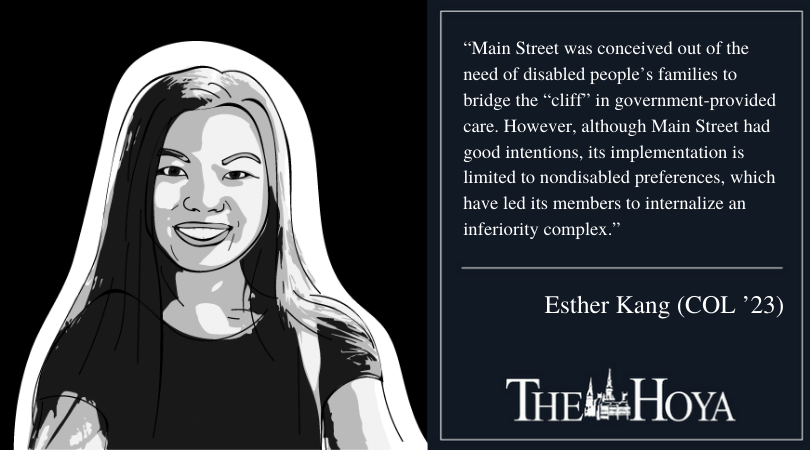On Oct. 31, 2019, Jillian Copeland and David Godoy visited my Ignatius Seminar, “Disability, Culture, and Question of Care.” Copeland is the founder of Main Street, a disability-inclusive residential complex planned for development in Washington, D.C., after its first completed construction in Rockville, Md. Godoy, an immigrant from Ecuador with cerebral palsy, is a devoted advocate for the future of Main Street’s community. Although Copeland had good intentions behind planning Main Street, the project’s design has limited awareness of what disabled people might actually prefer in an ideal community. The ignorance underlying Main Street’s infrastructure demonstrates how easily the accessibility needs of disabled people are assumed for them by nondisabled people and therefore go unrecognized.
During her visit, Copeland took pride in how Main Street is a community in which verbalizing the word “inclusion” is no longer necessary. Given her lopsided presentation of Main Street and condescending treatment of Godoy, I do not doubt it. Inclusion in Main Street seems to go unsaid because it does not exist.
The limitations of Copeland’s vision for ideal community care are drawn from her experience caring for her disabled son. The issue with this parenting background is that Copeland’s personal association with disability inclined her to infantilize disabled people. This problem was evident in the way that Copeland would not readily let Godoy speak unless she permitted it, and the way she would prompt Godoy to talk about how her project had helped him grow. At one point, she also referred to Godoy as a “good boy” even though Godoy is 38 years old. The superficial presence of Godoy paired with his inability to speak unless spoken to are evidence of Copeland tokenizing Godoy’s identity.
More disturbing were the times Godoy did get to speak, as he expounded on Main Street’s ideologies. He claims that the community’s ideals of unwavering positivity and forgetting the negative aspects of disability helped him find happiness. He claims he is grateful to have “overcome” his disability all thanks to “Ms. Copeland.” However, the more he describes Main Street and “Ms. Copeland,” the harder it gets to reconcile his words with his tone, which is somehow overemphatic and emotionless at the same time. Indeed, much of what Godoy said reflects what nondisabled people are comfortable tolerating.
The problematic implementation of Main Street likewise draws from Copeland’s own self-identification as nondisabled. With misleading slogans like “Inclusivity Redefined,” Main Street leverages the inclusion of disabled people merely to promote the community’s appeal. Only a quarter of Main Street’s housing units are actually set aside for people with disabilities, while the remaining majority are not. Main Street’s inclusive community-building efforts also involve activities that are not particularly accessible to people with disabilities, with programs like yoga classes, cooking sessions and meditative strolls outside. It is unclear how these recreational options are the result of carefully engaging the disabled community and not simply assumed from the singular preferences of an able-bodied perspective.
The vision of Main Street infringes on the rights of disabled adults due to the narrowness of its founder. Like most institutions of care in the United States, Main Street was conceived out of the need of disabled people’s families to bridge the “cliff” in government-provided care. However, although Main Street had good intentions, its implementation is limited to nondisabled preferences, which have led its members to internalize an inferiority complex.
The danger in defending Copeland’s project arises from considering Main Street’s optimistic outlook, as it intends to “serve as a replicable model for integrated living and community structure.” As plans for a second Main Street community are already set in place to reach D.C., the Copelands actually need to redefine inclusivity for themselves before they decide to replicate the Main Street model in D.C.
Esther Kang is a freshman in the College. Reconstructing Disability appears online every other Tuesday.









